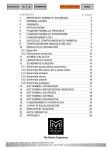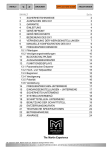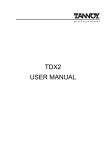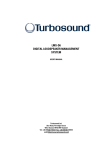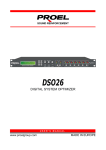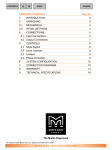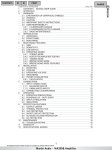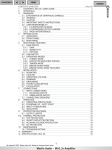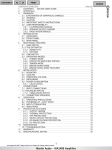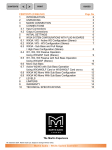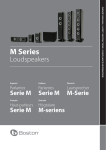Download Martin Audio DX1 Specifications
Transcript
CONTENTS < > PRINT APPLICATIONS GUIDE CONTENTS (ENGLISH) 1 IMPORTANT SAFETY INFORMATION 2 UNPACKING THE DX1 3 WARRANTY 4 INTRODUCTION 5 FRONT PANEL FUNCTIONS 6 REAR PANEL FUNCTIONS 7 OPERATING THE DX1 8 USING FACTORY PRESETS 9 CONFIGURING THE DX1 MANUALLY 10 CROSSOVER MODES 10.1 Filter slopes 10.2 Time alignment 11 BLOCK DIAGRAMS 12 OUTPUT LIMITERS 13 FUNCTION SCREENS 13.1 Parametric equaliser screen 13.2 High and lowpass filter screens 13.3 Limiter screen 13.4 Delay screen 13.5 Polarity screen 13.6 Gain screen 14 CROSSOVER SUB-MENU 15 INPUT SETUP SUB-MENU 16 SECURITY SUB-MENU 17 SYSTEM SUB-MENU 18 INTERFACE SUB-MENU 19 INTERFACE OPERATION 20 EQUALISATION CURVES 21 TECHNICAL SPECIFICATIONS 22 OPERATING NOTES 23 APPENDICES GUIDES Page No 2 3 3 4 5 6 7 7 9 9 9 10 11 13 14 14 15 15 16 16 16 17 17 18 19 19 19 20 22 23 24 MARTIN AUDIO L O N D O N The Martin Experience Martin Audio – DX1 Speaker Management System > PRINT APPLICATIONS GUIDE GUIDES This equipment conforms to the requirements of the EMC Directive 89/336/EEC, amended by 92/31/EEC and 93/68/EEC and the requirements of the Low Voltage Directive 73/23/EEC, amended by 93/68/EEC. Standards Applied EMC Emission Immunity Electrical Safety 1 EN55103-1:1996 EN55103-2:1996 EN60065:1993 IMPORTANT SAFETY INFORMATION Do not remove Covers. No user serviceable parts inside, refer servicing to qualified service personnel. This equipment must be earthed. ! CAUTION RISK OF ELECTRIC SHOCK DO NOT OPEN DO NOT EXPOSE TO RAIN OR MOISTURE It should not be necessary to remove any protective earth or signal cable shield connections. Do not defeat the purpose of the polarized or grounding-type plug. A polarized plug has two blades with one wider than the other. A grounding type plug has two blades and a third grounding prong. The wider blade and the third prong are provided for your safety. When the provided plug does not fit into your outlet, consult an electrician for replacement of the obsolete outlet. Only use this equipment with an appropriate mains cord. In the USA the cord should comply with the requirements contained in the Standard for Cord Sets and Power Supply Cords, UL 817, be marked VW-1, and have an ampacity rating not less than the marked rating of the apparatus. 2 Martin Audio – DX1 Speaker Management System ENGLISH < CONTENTS > PRINT APPLICATIONS GUIDE GUIDES Thank you for purchasing the Martin Audio DX1 Loudspeaker Management System. The DX1 is designed to compliment all our current loudspeaker products that require or benefit from the use of a system controller. 2 UNPACKING THE DX1 Each Martin Audio DX1 controller is built, tested and thoroughly inspected to the highest standard before leaving the factory. After unpacking the unit please examine it for any signs of transit damage and inform your dealer if any such damage is found. Please retain all packaging in case of future re-shipment. Please note that Martin Audio and it’s distributors cannot accept responsibility for damage to any returned product through the use of non approved packaging. 3 WARRANTY Martin Audio DX1 Speaker Management Systems are warranted against manufacturing defects in materials or craftsmanship over a period of 1 year from the date of original purchase. During the warranty period Martin Audio will, at it's discretion, either repair or replace products which prove to be defective provided that the product is returned in its original packaging, shipping prepaid, to an authorised Martin Audio service agent or distributor. Martin Audio Ltd. cannot be held responsible for defects caused by unauthorised modifications, improper use, negligence, exposure to inclement weather conditions, act of God or accident, or any use of this product that is not in accordance with the instructions provided by Martin Audio. Martin Audio is not liable for consequential damages. This warranty is exclusive and no other warranty is expressed or implied. This warranty does not affect your statutory rights. 3 Martin Audio – DX1 Speaker Management System ENGLISH < CONTENTS 4 > PRINT APPLICATIONS GUIDE GUIDES INTRODUCTION The DX1 is a compact and powerful DSP based audio-processing unit ideally suited for live applications and fixed installations. To achieve this the DX1 has 2 inputs and 6 outputs, which can be configured in 5 basic modes, 2 x 2 way, 2 x 3 way, 4 way, 5 way and 6 way crossover. Each input has adjustable gain and delay, each output consists of a high and lowpass filter, 5 bands of parametric equalisation, limiter, delay (adjustable in 2.6ms steps), gain and polarity controls. RS232 interface and user memories are provided as well as a multi-level security 'lock-out' function for all controls. The DX1 is supplied pre loaded with the most common configurations for all of our current product ranges that require or benefit from the use of a system controller. Factory presets can easily be updated by downloading the current file via a PC. The DX1 can also be used as a fully configurable electronic crossover system incorporating all of the features listed below. Features • Superb audio quality: Carefully optimised Double Precision processing plus 40 bit internal data path for exceptional dynamic range and sonic quality. • A flexible 2 input, 6 output multi-mode format featuring a choice of 2 x 2 way, 2 x 3 way, 4 + 2 way, 5 + 1 way and 6 way crossover modes with limiters. • Each parametric section provides +15dB to -30dB of gain at centre frequencies between 20Hz - 20kHz with a wide range of Qs from 0.4 to 128. All parameters feature fine resolution with 1/36th octave frequency steps, 0.1dB gain increments and 100 Q settings. Any parametric section can be set for LF & HF shelving response. • Six high performance limiters are provided, featuring a wide range of control over Attack, Release and Threshold parameters. The output meters show headroom to the limit threshold. The meter time constants track the limiter time constants to show precise power usage. • Variable High and Low pass filters for each output can be set for 12, 18 and 24dB per octave slopes with a choice of Bessel, Butterworth or Linkwitz-Riley responses. Independent control over High & Lowpass functions allows asymmetric crossover functions to be realised. • Three velocity-sensitive rotary encoders provide a familiar and easy to use control format with all filter information displayed simultaneously on a backlit LCD display. • Delay of up to 650mS can be independently set for each output with a minimum increment of 2.6µs. • Comprehensive standard specification includes a maximum of 80 factory presets, 19 user memories, RS232 interface for factory preset updates via a PC and a multi-level security lockout function. • The DX1 provides exceptional audio quality with a full >110dB dynamic range, high sampling rate and minimal filtering. 4 Martin Audio – DX1 Speaker Management System ENGLISH < CONTENTS 5 > PRINT APPLICATIONS GUIDE GUIDES FRONT PANEL FUNCTIONS 5 4 'Q' FREQ 1 8 MENU ENTER BYPASS QUIT 9 6 3 <BACK> <NEXT> DX1 10 11 12 GAIN Digital Speaker Management System 7 2 1. LCD Display - Shows menu options, output information and various parameters being adjusted. 2. Gain Keys - Two input and six-output GAIN keys allow instant access to the gain screen for each channel. Pressing a second time selects the last function edited. 3. Next Key - Moves the display forwards through the list of available parameters for the current input or output channel. 4. Back Key - Moves the display backwards through the list of available parameters for the current input or output channel. 5. Menu Key - Activates the main menu on the LCD display. Pressing a second time selects the last menu edited. Different menus are selected by pressing the BACK and NEXT keys or using the FREQ control. 6. Enter Key - Enters the chosen menu and confirms menu selections. 7. Quit Key - Exits the menu. 8. Bypass Key - Allows the currently displayed parametric section to be bypassed. (Note: The Highpass / Lowpass filters and limiters cannot be bypassed.) 9. Parameter Controls - The three velocity sensitive rotary encoders allow the relevant parameter on the LCD screen to be adjusted. 10. Input Meters - Displays available headroom before input clipping occurs. The bottom LED displays the presence of signals between -24dB and -6dB of input headroom, with the orange LED set at 6dB below clipping. The top, red LED displays digital overflow and can therefore light without the other LEDs becoming illuminated. 11. Output Meters - Displays headroom before limiting occurs. The bottom LED displays between -24dB and -3dB of headroom, with the orange LED set at -3dB. The top, red LED is set at the limiter threshold for that channel. 12. Mute Keys - Six output mute keys with LED indicator. 5 Martin Audio – DX1 Speaker Management System ENGLISH < CONTENTS 6 > PRINT REAR PANEL FUNCTIONS POWER 1. 2. 3. 4. 5. MAINS IN 90V - 240V AC 50 - 60Hz 30W DO NOT EXPOSE TO RAIN OR MOISTURE EXTERNAL 1 GUIDES APPLICATIONS GUIDE 2 CAUTION FOR CONTINUED PROTECTION AGAINST FIRE REPLACE ONLY WITH SAME TYPE 11A, 250V FUSE 3 XLR PIN P1=SHIELD P2=HOT P3=COLD WARNING THIS EQUIPMENT MUST BE EARTHED OUTPUT 6 OUTPUT 5 OUTPUT 4 OUTPUT 3 OUTPUT 2 OUTPUT 1 INPUT B INPUT A CAUTION SHOCK HAZARD DO NOT REMOVE COVERS. AVIS RISQUE DE CHOC ELECTRIQUE, NE PAS OUVRIR. MADE IN THE UK 4 5 Power Switch. Mains Fuse - Located in a finger-proof fuseholder adjacent to the mains inlet. Always replace this fuse with the correct type as shown on the rear panel legend. (N.B. A spare fuse is located in this holder.) Mains Power - Connected via a standard IEC socket. A compatible power cord is supplied with the unit. External - RS232 via a 9-pin DIN DEE socket, for connection to a PC. XLR Inputs and Outputs - 3 pin XLR connectors are provided for each audio input and output. All terminations are fully balanced, pin 2 Hot, pin 3 Cold and pin 1 Screen (shield). 6 Martin Audio – DX1 Speaker Management System ENGLISH < CONTENTS 7 > PRINT APPLICATIONS GUIDE GUIDES OPERATING THE DX1 The DX1 can be used in two ways: 1. Using pre loaded factory presets to configure the DX1 for use with Martin Audio products. 2. As a generic digital loudspeaker management system. Note: this requires the user to configure the DX1 manually, i.e. by entering crossover information via the controls on the front panel. The DX1 is equipped with 19 user memories for storing these configurations. 8 USING FACTORY PRESETS The DX1 is supplied pre loaded with the most common configurations for all our current product ranges that require or benefit from the use of a system controller. This section shows how to get up and running quickly by loading and configuring a factory preset without having to read the entire manual. Loading a factory preset 1. Turn the unit on via the mains switch on the rear panel. The unit displays the version number of the factory preset file and starts the ‘wake up’ routine. After ten seconds the unit becomes operational and is now ready to load a preset. 2. Press MENU followed by ENTER. The display will read "Load a crossover". Press ENTER again. When using the unit for the first time the display shows "1:". This is the first of the 19 user memories. At this stage all of the user memories will be empty. Use the FREQ control to scroll forward to the required preset (see Appendix 3), the factory presets start at number 20. Note: If you have already loaded a preset previously the display will show the name and number of the last preset that you loaded. 3. Once the required preset is displayed, press ENTER. The display will prompt "[ENTER] for Recall.", press ENTER and the preset will instantly be loaded. Note: if you have already loaded a preset in to the unit and want to load a different preset you will be prompted "Different crossover ??? [ENTER] for Recall." after you press ENTER. Press ENTER again and the selected preset will be loaded in place of the previous one. Note: If no action is taken after ten seconds in the menu mode the unit will return to normal 'default' mode. Repeat instructions 2. and 3. to return to menu mode. 7 Martin Audio – DX1 Speaker Management System ENGLISH < CONTENTS > PRINT APPLICATIONS GUIDE GUIDES Configuring a factory preset Once a preset has been loaded there are three user configurable parameters. Note: all other parameters accessed via the GAIN buttons, such as crossover points and parametric equalisation are locked and cannot be altered by the user. 1. 2. 3. Output gain trim: The gain of each output channel can be adjusted by plus or minus 6dB. This is intended for normalising power amplifiers of differing gain. To alter gain trim press the GAIN button of the channel to be adjusted. The display now shows "Trim = 0 dB". Use the rotary control marked GAIN to adjust the channel gain as required. Output delay: This parameter can be altered in a system incorporating more than one stereo pair of speakers in order to set inter cabinet delays, for example: between a subwoofer and a mid-high cabinet. Use the rotary FREQ control for 1ms increments and the rotary Q control for 2.6ms increments. Note: inter driver delays within a cabinet are linked together so that altering one delay will automatically adjust the other to keep drivers perfectly aligned. Output limiters: All factory presets are supplied with the limiters set at their maximum level and with the time constant set to automatic. Use the rotary GAIN control to adjust the limit level. It is essential that the user sets the correct limit level in order to protect both amplifiers and speakers in the system. Note: the correct limit level is determined by the output of the power amplifiers and power handling of the speaker system. As a general rule of thumb, if the amplifier is clipping turn the limit level down! Please refer to Appendix 1 for a table of dBu to Vrms conversion. The user can also edit the gain of the input channels as well as the overall system delay. This is most applicable when configuring a system that features multiple speaker systems and multiple DX1 controllers. Note: all of the above settings are retained when the unit is switched off. Once the preset has been configured it can be locked so that the unit cannot be accessed by unauthorised personnel, see ‘Security Sub-menu’ on page 18. For a description of how to connect signal inputs and outputs to the DX1 please refer to the block diagrams on pages 11 and 12. Please note how the output connector configuration changes with respect to frequency bands (eg: low, mid, high) as the configuration of the controller changes, i.e. 2x2 way, 1x4 way, 1x6 way etc. Appendix 3 explains which outputs the frequency bands are assigned to for each preset. Once the preset is loaded, configured and connected to the rest of the system in accordance with the block diagrams on pages 11 and 12, it is now ready for use. 8 Martin Audio – DX1 Speaker Management System ENGLISH < CONTENTS 9 > PRINT APPLICATIONS GUIDE GUIDES CONFIGURING THE DX1 MANUALLY Introduction This section describes how to use the DX1 as a generic loudspeaker management system. We recommend that you read the whole of the manual before using the DX1 in this manner. To simplify set-up of the DX1, 5 crossover modes are menu selectable. These all have parametric equalisers, high and low pass filters, limiters, gain and delay. For detailed information on these modes please study the block diagrams along with the following descriptions. The 2x2 way and 2x3 way crossover modes have the option available to provide precise 'ganged' parameter adjustment for stereo sources. 10 CROSSOVER MODES All crossover modes feature adjustable crossover frequencies with a choice of slopes, 5 bands of driver compensation E.Q. per output, delay time, limiters and absolute phase adjustment for each output. 10.1 Filter slopes A choice of Bessel or Butterworth slopes at 12/18/24dB per octave and Linkwitz-Riley at 24dB per octave are provided. Since Low and High pass functions are separately adjusted, asymmetric slopes are easily achieved if required. It should also be noted that the turnover frequency displayed on the DX1 is the -3dB point for all slopes except 24dB Linkwitz-Riley where the -6dB point is shown. If the -6dB point is to be used for the Bessel or Butterworth filter, take the required crossover frequency, multiply this by the appropriate factor from the following table and then select the closest available frequency on the DX1 display. Filter Type High pass filter factors Low pass filter factors Bessel 12dB/octave 1.45 0.69 Butterworth 12dB/octave 1.31 0.76 Bessel 18dB/octave 1.37 0.73 Butterworth 18dB/octave 1.19 0.84 Bessel 24dB/octave 1.35 0.74 Butterworth 24dB/octave 1.15 0.87 Please note that unlike conventional analogue crossovers, crossover points and slopes are set with absolute accuracy since component tolerance problems do not occur. 9 Martin Audio – DX1 Speaker Management System ENGLISH < CONTENTS < > PRINT APPLICATIONS GUIDE GUIDES 10.2 Time Alignment A further advantage of the DX1 over conventional products is the provision of an independently adjustable delay section for each output. This allows the true arrival time from multiple drivers to precisely aligned rather than relying on the compromise 'phase adjust' approach. Delay time is adjustable in 2.6µs steps (1mm). To convert from units of time (i.e. milliseconds) to units of distance use the following formula: 1 millisecond = 343mm (1.126ft) @ 20°C (68°F) or to calculate time delay for a known distance, use: Time delay = Distance in meters 20.06 x √273+˚C Where ˚C is the temperature in ˚C. Or to simplify this equation at 20˚C. Delay time in milliseconds = Distance in meters x 2.192. Or delay time in milliseconds = Distance in feet x 0.955 (N.B. Centigrade = (Fahrenheit –32) x 0.5555). 10 Martin Audio – DX1 Speaker Management System ENGLISH CONTENTS < 11 > PRINT APPLICATIONS GUIDE GUIDES BLOCK DIAGRAMS DX1 2 X 2 WAY + SUM A+B CROSSOVER DX1 2 X 3 WAY CROSSOVER 11 Martin Audio – DX1 Speaker Management System ENGLISH CONTENTS < > PRINT APPLICATIONS GUIDE GUIDES DX1 4 WAY CROSSOVER + 2 AUX DX1 5 WAY CROSSOVER + 1 AUX DX1 6 WAY CROSSOVER 12 Martin Audio – DX1 Speaker Management System ENGLISH CONTENTS < 12 > PRINT APPLICATIONS GUIDE GUIDES OUTPUT LIMITERS High performance digital limiters are provided for each output with control over attack time, release time and threshold level parameters (see page 15). This level of control allows the user to balance the required subjective quality of the limiter against the driver protection requirements. It does also mean that an incorrectly set limiter may sound awful! In particular, as with all limiters, using too fast an attack or release time will result in excessive low frequency distortion. In the ‘design a crossover’ sub-menu there is an option for automatic limiter time constants. In this mode the time constants will be automatically set from the Highpass filter frequency. See table below. Table of automatic attack and release times. The time constants are set by the high pass filter frequency for that channel. It is highly recommended that the automatic setting is used to ensure highest sound quality and simplicity of configuration. High pass filter Auto attack time Release <10Hz – 31Hz 45ms x16 (720ms) 31Hz – 63Hz 16ms x16 (256ms) 63Hz – 125Hz 8ms x16 (128ms) 125Hz – 250Hz 4ms x16 (64ms) 250Hz – 500Hz 2ms x16 (32ms) 500Hz - 1kHz 1ms x16 (16ms) 1kHz – 2kHz 0.5ms x16 (8ms) 2kHz – 22kHz 0.3ms x16 (4ms) 13 Martin Audio – DX1 Speaker Management System ENGLISH CONTENTS < > PRINT APPLICATIONS GUIDE 13 FUNCTION SCREENS 13.1 Parametric equaliser screen GUIDES OP1+4 Low PEQ:1 ◊ 1K00Hz Q=3.0 0.0dB All modes feature 5 bands of fully flexible parametric equalisation per output, with all sections selectable to Low or High frequency shelving response. Each parametric section can be positioned at a frequency from 20Hz to 20kHz and features a wide range of 'Qs’ to produce response curves ranging from broad to notch. The gain control ranges from +15dB to -30dB in 0.1dB steps. Frequency steps are 1/36 octave resolution for precise control. Since all filtering is achieved in DSP all settings are re-settable with absolute accuracy and in ganged mode parameters track identically. Very narrow band notch filters (maximum Q of 128) can be achieved and unlike analogue filters these 'tight' Q filters are entirely stable. The maximum notch depth is -30dB. Parametric filters are carefully implemented using Double Precision processing. This method is costly in terms of processing power but yields substantial benefits in terms of the DX1’s exceptional noise performance and greatly improved low frequency stability. To adjust parametric settings: Use the FREQ control for the frequency. Use the Q control for the Q. Use the GAIN control for the gain. Use the BYPASS key to switch the parametric filter in and out of circuit. Note: the diamond symbol in the top right hand corner of the display indicates that the filter is in circuit and the horizontal line symbol shows that it is out. (N.B. To show parametric filters in bandwidth (BW) rather than Q, go into the system sub-menu, select ’filter Q or BW’ and then select ‘BW’.) 14 Martin Audio – DX1 Speaker Management System ENGLISH CONTENTS < 13.2 > PRINT APPLICATIONS GUIDE GUIDES High and lowpass filter screens OP1+4 <10Hz Low HPF Bessel 24dB Each output has an independent high pass filter and an independent low pass filter. Both filters have a range of selectable slopes which are Bessel 12dB, 18dB and 24dB, Butterworth 12dB, 18dB and 24dB, and Linkwitz Riley 24dB. Highpass filters have a range of <10Hz (through) to 16kHz and Lowpass filters have a range of 22kHz (through) to 59Hz in 1/36 octave steps. HPFs and LPFs can be asymmetrically set. To adjust HPF/LPF settings: Use the FREQ control for the frequency. Use the Q control for the slope. 13.3 Limiter screen OP2+5 Mid Atk:4.0mS Limiter Rx16 Each output has an independent high performance limiter. All limiters have an attack range of 0.3ms to 90ms, release times are 4, 8, 16 and 32 times the attack time and thresholds range from +22dB to –10dB in 1dB steps. If the automatic limiter time constant option is in use, all limiter screens will say ‘automatic’ and the time constants will be set from the Highpass filter frequency. A table of dB to Vrms is in appendix 1. The output meters are linked to the time constants of the limiters so true output metering is achieved. To adjust limiter settings: Use the FREQ control to adjust the attack time. Use the Q control for the release time. Use the GAIN control for the limiter threshold. 15 Martin Audio – DX1 Speaker Management System ENGLISH CONTENTS < 13.4 > PRINT APPLICATIONS GUIDE GUIDES Delay screen OP1 Delay Low = 1.003mS Each output has an independent delay time control. This can be adjusted in 2.6µS steps or in 1ms steps giving complete control over driver time alignment. Input delay (base delay) is adjustable in 1ms steps only. To adjust delay settings: Use the FREQ control for coarse control. (1ms steps) Use the Q control for fine control. (2.6µS steps) 13.5 Polarity screen OP1 Low Polarity = [ + ] Each output has an independent polarity screen. This gives the flexibility to reverse (flip by 180˚) the phase of individual outputs. (N.B. When the outputs are ganged, the polarity screens remain individual.) To adjust the polarity: Use the GAIN control to switch between + and -. 13.6 Gain screen O/P1+3 Low Gain = 0.1dB Each output and input has an individual gain screen. The outputs have a range of +15dB to –40dB, adjustable in 0.1dB steps and the inputs have a range of +6dB to –40dB, again adjustable in 0.1dB steps. To adjust the gain: Use the GAIN control. 16 Martin Audio – DX1 Speaker Management System ENGLISH CONTENTS < 14 > PRINT APPLICATIONS GUIDE GUIDES CROSSOVER SUB-MENU Press MENU and select crossover Sub-menu using the BACK, NEXT and ENTER keys. Three options are available in this sub-menu which are: Load a crossover Loads a factory preset or crossover stored in a user memory. Note: the unit ships with all user memories empty. It is up to the user to program these memories as the application requires. However, all the most common settings for our products are included in the factory presets for your convenience and in the majority of cases it will not be necessary to use this option. Note: loading a crossover will not overwrite the input settings. Design a crossover Opens a utility to design a crossover. Options include format type, ganging of outputs, routing and automatic limiter time constants. Store a crossover Stores a crossover (all output settings) to one of 19 user memories. Use the FREQ control to select the memory number. Press ENTER and you will be prompted to set the memory name. Use the FREQ control to scroll through the available characters. Use the NEXT key to move to the next character. The memory name can contain up to 16 characters. Press ENTER to store to memory. Note: this sequence must be completed for a memory to store. If after 15 seconds no store has been implemented the unit will return to the default mode. When storing a memory the LCD shows the next available empty memory automatically but any user memory number can be chosen and any user memory can be overwritten. Previously used memories are identified by a '?' question mark. Note: the factory presets cannot be overwritten. If you want to make a permanent record of the user configurable settings of a factory preset, the preset can be saved to a user memory by following the above procedure. This is especially useful if the unit is to be used with a variety of presets on a regular basis. This will not unlock the ‘locked’ parameters of the preset! Note: it is not possible to save the input settings to a user memory. 15 INPUT SETUP SUBMENU Press MENU and select Input Set-up Sub-menu using the BACK, NEXT and ENTER keys. There is one option in this menu: Gang Inputs: Gangs A and B inputs so that precise adjustments can be made to both inputs simultaneously. In this mode the LCD will show A+B when either of the input ‘GAIN’ buttons are pressed. 17 Martin Audio – DX1 Speaker Management System ENGLISH CONTENTS < 16 > PRINT APPLICATIONS GUIDE GUIDES SECURITY SUB-MENU Press MENU and select Security Sub-menu using the BACK, NEXT and ENTER keys. Press ENTER to load one of the four selections (See below). A four-digit security code will be asked for. This can be entered by using the FREQ control, to select a character, and the BACK and NEXT keys to move to the next character. Alternatively, the GAIN keys can be used to enter a code by pressing any combination of the eight buttons. Each GAIN key represents it’s channel labelling, so any combination of A, B, 1, 2, 3, 4, 5 and 6 can be used as a code. Lock options: Changes only: This option locks all parameters so that no changes can be made, including all menus. Changes + view: This option locks all parameters and the viewing of them on the LCD including all menus. Changes + mutes: This option locks all parameters, including all menus, and disables all mute keys. Everything: This option locks all parameters and the viewing of them, including all menus, and disables all mute keys. To 'unlock' the security system, press the MENU key and enter correct code. IMPORTANT - Please Note that once the security system is initiated only re-entering the correct code will 'unlock' the DX1's functions. Please note the code! If the security code number is inadvertently lost contact your local Martin Audio sales office. 18 Martin Audio – DX1 Speaker Management System ENGLISH CONTENTS < 17 > PRINT APPLICATIONS GUIDE GUIDES SYSTEM SUB-MENU Press MENU and select System Sub-menu using the BACK, NEXT and ENTER keys. Several options are available in this sub-menu which are: System Status: Displays unit information including software version and temperature. Curr. Temp. = current temperature in degrees Celsius. Max1. Temp. = maximum temperature this session. Max2. Temp. = maximum temperature ever reached. LCD Contrast: Adjusts the LCD contrast from 0 to 100. LED Brightness: Adjusts the LED brightness from 1 to 15. Temperature Alarm: Sets a temperature warning between 20 and 80˚C. The default screen will flash ‘ALARM. Temp = n˚C’ when the specified temperature is reached. (N.B. the warning does not affect the performance of the unit in any respect.) This feature is intended to alert the user to changes air temperature which will have a consequent effect on delay time. This is of use when aligning remotely sited ‘delay stacks’ as opposed to inter drive unit delays. See page 10 for an explanation of the relationship between air temperature and delay time. Wake-up Time: Sets how the unit starts up with one of the following options. 0 to 60 seconds: Waits the specified time before unit wakes up. Mute hold: Turns on and holds all output mutes when turned on. (N.B. Wake-up is a slow ramp in level for about 5 seconds.) Output Meters: Selects whether the output meters are pre or post mute. Filter Q or BW: Selects whether ‘Q’ or Bandwidth is displayed in the parametric screens. Delay Time/Distance: Selects the display of delay in milliseconds, metres or feet. 18 INTERFACE SUB-MENU Press MENU and select crossover Sub-menu using the BACK, NEXT and ENTER keys. Interface Setup Opens a utility to configure the RS232 interface. 19 INTERFACE OPERATION The DX1 has a RS232 external interface. This allows the factory presets in the DX1 to be updated via a PC. Updates will occur when new products that require the use of a controller are released. Instructions on how to load the latest factory preset file will be supplied with the factory preset file and it’s accompanying downloading software. RS232 interface configuration Select the following options in the Interface Setup menu: External Mode: On. RS232 Baud: 2400, 4800, 9600, 19200, 38400 (Select the baud rate, this should correspond to the baud rate set on the computer.) 19 Martin Audio – DX1 Speaker Management System ENGLISH CONTENTS < 20 > PRINT APPLICATIONS GUIDE GUIDES EQUALISATION CURVES Frequency = 1kHz, Q=4.0 Parametric filter gain curves. Frequency (Hz) Frequency = 1kHz, Gain = +15dB Parametric filter 'Q' curves. Frequency (Hz) Lowshelf @ 100Hz Highshelf @ 5kHz Frequency (Hz) Parametric filter High and Low shelf curves. 20 Martin Audio – DX1 Speaker Management System ENGLISH CONTENTS < > PRINT APPLICATIONS GUIDE GUIDES a = Bessel 12dB (50Hz) b = Butterworth 12dB (50Hz) c = Bessel 24dB (200Hz) d = Butterworth 24dB (200Hz) e = Linkwitz-Riley 24dB (500Hz) Highpass filter curves. Frequency (Hz) a = Linkwitz-Riley 24dB (1kHz) b = Butterworth 24dB (2kHz) c = Bessel 24dB (2kHz) d = Butterworth 12dB (5kHz) e = Bessel 12dB (5kHz) Lowpass filter curves. Frequency (Hz) Frequency = 1kHz, Q=128, Gain = -30dB Frequency (Hz) Parametric filter with high 'Q' to achieve notch response. 21 Martin Audio – DX1 Speaker Management System ENGLISH CONTENTS < > 21 PRINT APPLICATIONS GUIDE GUIDES TECHNICAL SPECIFICATIONS Inputs Two electronically balanced. > 10k ohms. >65dB 50Hz - 10kHz. Impedance CMRR Outputs Source Imp Min. Load Max. Level Six electronically balanced. < 60ohms. 600ohm. +20dBm into 600 ohm load. Frequency Resp. Dynamic Range Distortion Maximum Delay Output gain Input gain ±0.5dB 20Hz - 20kHz. >110dB 20Hz -20kHz. Unwtd. < 0.02% @ 1kHz, +18dBm. 650 ms. (Increment 2.6 µs) adjustable +15dB to -40dB in 0.1dB steps and mute. Adjustable +6dB to -40dB in 0.1dB steps. Parametric Equalisation Filters Filter gain Centre frequency Filter Q / BW 5 Sections per output. +15dB to -30dB in 0.1dB steps. 20Hz - 20kHz, 1/36 octave steps. (368 positions) 0.4 to 128 / 2.5 to 0.008 (Sections switched to shelving response) Low frequency High frequency Shelf gains 20Hz - 1kHz 1kHz - 20kHz ±15dB in 0.1dB steps. High and Lowpass Filters Filters Frequency (HPF) Frequency (LPF) Response 1 of each per output. 10Hz - 16kHz, 1/36 octave steps. 60Hz - 22kHz, 1/36 octave steps. Bessel / Butterworth 12/18/24dB per octave and Linkwitz-Riley 24dB per octave. Limiters Threshold Attack time Release time +22dBu to -10dBu. 0.3 to 90 milliseconds. 4, 8, 16 or 32 times the attack time. Display Input meter Output meter Connectors 2 x 20 character backlit LCD. 2 x 3 point, -24dB to digital clip. 6 x 3 point, -24dB to limit level. Inputs Outputs External Power 3 pin female XLR. 3 pin male XLR. 9 pin DEE connector (RS232) 3 pin IEC. Power 60 to 250V ±15% @ 50/60Hz. Consumption < 20 watts. Weight 3.5kg. Net (4.8kg. Shipping) Dimensions(1U) (W) 482mm x (H) 44mm x (D) 300mm (excluding connectors). (W) 19ins x (H) 1.75ins x (D) 11.8ins (excluding connectors). Shipping Dimensions(1U)(W) 560mm x (H) 115mm x (D) 425mm (excluding connectors). (W) 22ins x (H) 4.5ins x (D) 16.7ins (excluding connectors). Due to continuing product improvement the above specifications are subject to change. 22 Martin Audio – DX1 Speaker Management System ENGLISH CONTENTS < 22 > PRINT APPLICATIONS GUIDE GUIDES OPERATING NOTES What happens on switch on? As mentioned previously the DX1 can be programmed to go through a ‘Wake up’ sequence which ramps up the output level over a set time period. The default is a wake up time of 10 seconds. The DX1 remembers exactly how it was set up before it was switched off. This includes which preset or user memory was loaded and the associated gain, delay and limiter levels etc. It also remembers the input settings and the status of the MUTE buttons. All of the factory presets are programmed to unmute themselves automatically but this is overridden if the user manually mutes the outputs prior to switching the unit off. This is of particular note in fixed installations where an operator may decide to mute the outputs at the end of a performance and then turn the unit off. The next time the unit is powered up the mutes will stay on after the wake up routine has finished. Grounding The Screen (shield) pins on all audio connectors are normally connected directly to the ground pin of the IEC mains inlet. The chassis is also directly connected to this pin. Never operate this unit without the mains safety ground connected. Signal ground (0V) is in turn connected to the chassis ground. To avoid ground loops, cable shields should be connected to ground at one end only. The normal convention is that the shield is only connected at the output XLR. Provision is also made for separately isolating each input and output shield pin permanently within the DX1 by breaking the appropriate PCB track, where marked with a box and an arrow next to each XLR connector using a small drill bit or cutter. See the following diagram for details. XLR pin 1 Isolation points and 10dB pads 23 Martin Audio – DX1 Speaker Management System ENGLISH CONTENTS < 23 > PRINT APPLICATIONS GUIDE GUIDES APPENDICES Appendix 1 Limiter threshold in dBu to Vrms lookup table. dBu Vrms dBu Vrms +22 9.75 +5 1.38 +21 8.69 +4 1.23 +20 7.75 +3 1.09 +19 6.90 +2 0.98 +18 6.15 +1 0.87 +17 5.48 0 0.77 +16 4.89 -1 0.69 +15 4.36 -2 0.62 +14 3.88 -3 0.55 +13 3.46 -4 0.49 +12 3.08 -5 0.44 +11 2.75 -6 0.39 +10 2.45 -7 0.35 +9 2.18 -8 0.31 +8 1.95 -9 0.27 +7 1.73 -10 0.24 +6 1.55 -11 0.22 Calculation: Vrms = 0.7746 x 10 ^ (dBu / 20) 24 Martin Audio – DX1 Speaker Management System ENGLISH CONTENTS < > PRINT APPLICATIONS GUIDE GUIDES Appendix 2 Below are the default crossover settings and names for all configurations. Note: these values are intended as arbitrary starting points and do not correspond to any of the values in the factory presets. X-over Output 1 Output 2 Output 3 Output 4 Output 5 Output 6 2x2 way+Ms Low High Low High Msub Aux 120Hz – 1k82Hz 1k82Hz – 22kHz 120Hz – 1k82Hz Low Mid High 22.1Hz – 120Hz 120Hz – 1k82Hz 1k82Hz – 22kHz Low LoMid HiMid High 15Hz – 149Hz 149Hz – 1k31Hz 1k31Hz – 8kHz 8kHz – 22kHz Sub Low LoMid HiMid High Aux 15Hz – 80.3Hz 80.3Hz – 180Hz 180Hz – 1k31Hz 1k31Hz – 8kHz 8kHz – 22kHz 20.1Hz – 22kHz LoSub Sub Low LoMid HiMid High 15Hz – 80.3Hz 80.3Hz – 149Hz 149Hz – 1kHz 1kHz – 4kHz 2 x 3 way 4 way + 2 5 way + 1 6 way 1k82Hz – 22kHz 24.8Hz – 120Hz <10Hz – 22kHz Low Mid High 22.1Hz – 120Hz 120Hz – 1k82Hz 1k82Hz – 22kHz Aux Aux 20.1Hz – 22kHz 20.1Hz – 22kHz 4kHz – 10k1Hz 10k1Hz – 22kHz Note: All filters set to 24dB Linkwitz-Riley. 25 Martin Audio – DX1 Speaker Management System ENGLISH CONTENTS < > PRINT APPLICATIONS GUIDE GUIDES ENGLISH CONTENTS Appendix 3 Factory Preset File version 1.2, 19th June 2002 Preset number Loudspeaker system Configuration Input A Input B Output 1 Output 2 Output 3 Output 4 Output 5 Output 6 20 21 22 23 24 25 26 WAVEFRONT W8+WSX 3 WAY PASSIVE W8+WSX 4 WAY ACTIVE W8+W8S OR CS 3 WAY PASSIVE W8+W8S OR CS 4 WAY ACTIVE W8+W8S 5 WAY ACTIVE W8+WSX 4 WAY ACTIVE HF LIFT W8 LONGTHROW+WSX 2x3 way 1x4 way 2x3 way 1x4 way 1x5 way 1x4 way 1x4 way o/p 1 to 3 o/p 1 to 4 o/p 1 to 3 o/p 1 to 4 o/p 1 to 5 o/p 1 to 4 o/p 1 to 4 o/p 4 to 6 o/p 5 to 6 o/p 4 to 6 o/p 5 to 6 o/p 6 o/p 5 to 6 o/p 5 to 6 Low Low Low Low Low18 Low Low Lomid Lomid Lomid Lomid Low15 Lomid Lomid Midhi Himid Midhi Himid Lomid Himid Himid Low High Low High Himid High High Lomid Aux Lomid Aux High Aux Aux Midhi Aux Midhi Aux Aux Aux Aux 27 28 29 30 31 32 33 34 35 W1/W2PASSIVE/W3P W1/W2 PASSIVE/W3P+WS2A W2 ACTIVE W2 ACTIVE+WS2A W2 ACTIVE+W8CS W3 W3+WS2A W3+W8CS W3+WSX 2x2 way 2x2 way 2x2 way 2x3 way 2x3 way 2x2 way 2x3 way 2x3 way 2x3 way o/p 1 & 2 o/p 1 & 2 o/p 1 & 2 o/p 1 to 3 o/p 1 to 3 o/p 1 & 2 o/p 1 to 3 o/p 1 to 3 o/p 1 to 3 o/p 3 & 4 o/p 3 & 4 o/p 3 & 4 o/p 4 to 6 o/p 4 to 6 o/p 3 & 4 o/p 4 to 6 o/p 4 to 6 o/p 4 to 6 FR Sub Low Sub Sub Low Sub Sub Sub Aux HPass High Low Low Midhi Low Low Low FR Sub Low High High Low Midhi Midhi Midhi Aux HPass High Sub Sub Midhi Sub Sub Sub Sum A+B Msub Sum A+B Low Low Sum A+B Low Low Low Sum A+B Sum A+B Sum A+B High High Sum A+B Midhi Midhi Midhi 36 37 38 39 40 41 42 43 44 45 46 47 48 WT2 PASSIVE WT2 PASSIVE+WS2A WT2 ACTIVE WT2 ACTIVE+WS2A WT2 ACTIVE+W8CS WT3 BIAMP WT3 BIAMP+WS2A WT3 BIAMP+W8CS WT3 BIAMP+WSX WT3 TRIAMP WT3 TRIAMP+WS2A WT3 TRIAMP+W8CS WT3 TRIAMP+WSX 2x2 way 2x2 way 2x2 way 2x3 way 2x3 way 2x2 way 2x3 way 2x3 way 2x3 way 2x3 way 1x4 way 1x4 way 1x4 way o/p 1 & 2 o/p 1 & 2 o/p 1 & 2 o/p 1 to 3 o/p 1 to 3 o/p 1 & 2 o/p 1 to 3 o/p 1 to 3 o/p 1 to 3 o/p 1 to 3 o/p 1 to 4 o/p 1 to 4 o/p 1 to 4 o/p 3 & 4 o/p 3 & 4 o/p 3 & 4 o/p 4 to 6 o/p 4 to 6 o/p 3 & 4 o/p 4 to 6 o/p 4 to 6 o/p 4 to 6 o/p 4 to 6 o/p 5 to 6 o/p 5 to 6 o/p 5 to 6 FR Sub Low Sub Sub Low Sub Sub Sub Low Sub Sub Sub Aux HPass High Low Low Midhi Low Low Low Mid Low Low Low FR Sub Low High High Low Midhi Midhi Midhi High Mid Mid Mid Aux HPass High Sub Sub Midhi Sub Sub Sub Low High High High Sum A+B Msub Sum A+B Low Low Sum A+B Low Low Low Mid Aux Aux Aux Sum A+B Sum A+B Sum A+B High High Sum A+B Midhi Midhi Midhi High Aux Aux Aux 49 50 51 LE SERIES LE 400B/C LE 700/A LE12J BIAMP 2x2 way 2x2 way 2x2 way o/p 1 & 2 o/p 1 & 2 o/p 1 & 2 o/p 3 & 4 o/p 3 & 4 o/p 3 & 4 Low Low Low High High High Low Low Low High High High Sum A+B Sum A+B Sum A+B Sum A+B Sum A+B Sum A+B 52 53 54 55 56 57 58 59 60 61 62 63 64 65 66 67 68 69 70 BLACKLINE F8 2xF8+MONO S12 F10 F10+S12 OR MONO S15/S18 F12/F15 F12/F15+S15/S18 2xF12/F15+S218 F15A F15A+S15/S18 2xF15A+S218 F215 F215+S18 F215+S218 H2 PASSIVE+S218 H2 ACTIVE+S218 H3 H3+S218 H3T H3T+S218 2x2 way 2x2 way 2x2 way 2x2 way 2x2 way 2x2 way 2x2 way 2x2 way 2x3 way 2x3 way 2x2 way 2x2 way 2x2 way 2x2 way 2x3 way 2x2 way 2x3 way 2x3 way 1x4 way o/p 1 & 2 o/p 1 & 2 o/p 1 & 2 o/p 1 & 2 o/p 1 & 2 o/p 1 & 2 o/p 1 & 2 o/p 1 & 2 o/p 1 to 3 o/p 1 to 3 o/p 1 & 2 o/p 1 & 2 o/p 1 & 2 o/p 1 & 2 o/p 1 to 3 o/p 1 & 2 o/p 1 to 3 o/p 1 to 3 o/p 1 to 4 o/p 3 & 4 o/p 3 & 4 o/p 3 & 4 o/p 3 & 4 o/p 3 & 4 o/p 3 & 4 o/p 3 & 4 o/p 3 & 4 o/p 4 to 6 o/p 4 to 6 o/p 3 & 4 o/p 3 & 4 o/p 3 & 4 o/p 3 & 4 o/p 4 to 6 o/p 3 & 4 o/p 4 to 6 o/p 4 to 6 o/p 5 to 6 FR Sub FR Sub FR Sub Sub Low Sub Sub FR Sub Sub Low Low Low Sub Low Sub Aux HPass Aux HPass Aux HPass HPass High Low Low Aux HPass HPass Midhi Mid Midhi Low Mid Low FR Sub FR Sub FR Sub Sub Low High High FR Sub Sub Low High Low Midhi High Mid Aux HPass Aux HPass Aux HPass HPass High Sub Sub Aux HPass HPass Midhi Low Midhi Sub Low High Sum A+B Msub Sum A+B Msub Sum A+B Msub Msub Sum A+B Low Low Sum A+B Msub Msub Sum A+B Mid Sum A+B Low Mid Aux Sum A+B Sum A+B Sum A+B Sum A+B Sum A+B Sum A+B Sum A+B Sum A+B High High Sum A+B Sum A+B Sum A+B Sum A+B High Sum A+B Midhi High Aux 71 72 73 74 EM SERIES EM 15,26,56,76 EM 186 EM 15,26,56,76+EM 150/201/251 EM 186+EM201/251 2x2 way 2x2 way 2x2 way 2x3 way o/p 1 & 2 o/p 1 & 2 o/p 1 & 2 o/p 1 to 3 o/p 3 & 4 o/p 3 & 4 o/p 3 & 4 o/p 4 to 6 FR Low Sub Sub Aux Midhi HPass Low FR Low Sub Midhi Aux Midhi HPass Sub Sum A+B Sum A+B Msub Low Sum A+B Sum A+B Sum A+B Midhi Outputs marked 'Aux' or 'Sum A+B' can be configured by the user, please see 'Configuring the DX1 manually' for further explaination. The default settings for the 'Aux' and 'Sum A+B' outputs are 'flat', i.e. no filters, parametric eq, gain or delay. Outputs marked 'Msub' are the mono equivalent of the respective Sub outputs and are not user configurable. 26 Martin Audio – DX1 Speaker Management System CONTENTS < > PRINT DX1 APPLICATIONS GUIDE GUIDES Speaker Management System Please Click here to return to main menu Please Click here to visit our website MARTIN AUDIO L O N D O N The Martin Experience Century Point, Halifax Road, Cressex Business Park, High Wycombe, Buckinghamshire HP12 3SL, England. Telephone: +44 (0)1494 535312 Facsimile: +44 (0)1494 438669 Web: www.martin-audio.com E-mail: [email protected] CONTENTS < > PRINT APPLICATIONS GUIDE DX1 GUIDES Speaker Management System User’s Guide ENGLISH MARTIN AUDIO L O N D O N The Martin Experience




























